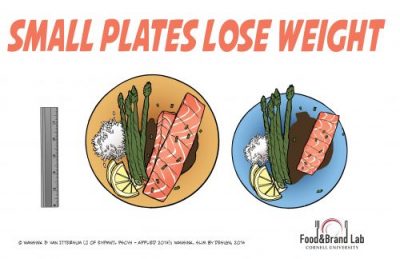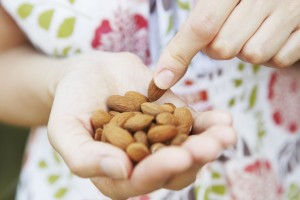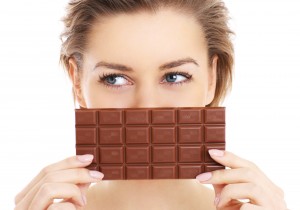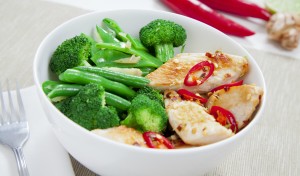“My doctor told me to stop having intimate dinners for four. Unless there are three other people.”
~ Orson Welles
Want to lose weight without feeling hungry? Then you should start by cutting 500 calories a day. If you create a 3500 calorie deficit in one week, you’ll lose one pound of fat. It’s that easy!
Making small changes to your diet is all it takes to lower your calorie intake. Simple things like replacing soda with water and tea, eating cottage cheese instead of aged cheese, and avoiding distractions while eating, can help you shed fat.
Ready to get started? Here are 10 simple ways to cut up to 500 calories a day:
1. Use Smaller Plates

Link: http://foodpsychology.cornell.edu/discoveries/large-plate-mistake
This work is licensed under a Creative Commons Attribution-NonCommercial-NoDerivatives 4.0 International License
As eating begins with our eyes as soon as we look at the food, it is also a visual process. Most of the times, we base our portions on plate size, not on hunger. Large plates make us serve and consume more food because portions appear smaller.
Research shows that an optical illusion can cause us to eat more than we think.
Filling smaller plate with food will trick your brain into thinking that you’re eating more, so you won’t feel any less full. This simple trick can help you reduce portion sizes without noticing.
Studies show that people who use smaller plates eat 20 to 25 percent less than they would normally do.
Healthy foods such as fresh vegetables should be served in larger plates to encourage consumption, while less healthy foods should be served in smaller plates to trick ourselves into feeling satisfied with less.
2. Limit Your Nut Intake

Almonds, walnuts, pistachios and other nuts are loaded with essential fatty acids, protein, and dietary fiber. The downside is that they have a lot of calories: ranging from about 500 to 700 calories in 3.5 oz. (or 100 g).
For example, macadamia nuts contain the most – 718 calories per 3.5 oz. (or 100 g), hazelnuts provide 628 calories per same amount, and peanuts have 567 calories. Chestnuts are lower in calories (213 Cal per 3.5 oz. or 100 g).
Roasted nuts have a higher glycemic index and more calories, so when choosing nuts, opt for raw and unsalted ones.
Nuts as a snack is a good choice for highly active people, bodybuilders, and athletes. However, they aren’t the best option for those who want to lose weight. Unless you have them occasionally and limit your portion to a serving size (i.e., a small handful or 1.5 ounces).
3. Replace Salad Dressing with a Healthier Option
Salad dressings and sauces can have as many as 500 calories per serving. Most restaurants are using salad toppings made with bacon, oil, butter, nuts, mayonnaise, honey, sugar and other high-calorie ingredients.
However, you can cut calories by ordering your dressing on the side and using only a small amount of it.
When eating at home you can replace salad dressing with your homemade dressing made from a mix of herbs, spices, lemon juice or vinegar (apple cider, balsamic), and a small amount of olive oil. If you want it to have a little creamy consistency, you may use low-fat yogurt, sour cream, or cottage cheese.
4. Don’t Eat in Front of the TV

People who snack while watching TV end up eating 300 calories more. While watching a movie or a TV show, you don’t pay close attention to your food and you don’t control your intake. This increases your chances of overeating.
Also, eating in front of the TV makes it harder to recall the amount consumed, so most of the time a person consumes more food later in the day.
Hunger isn’t the only thing that influences how much we eat during the day. Attention and memory also play roles.
It’s important to take time to eat a normal-sized meal slowly and without any distractions. By paying attention to what you are putting into your mouth, you can reduce your daily calorie intake.
5. Chew Your Food Well
Studies have found that chewing each mouthful of food 40 times instead of the average 15 can help reduce your calorie intake by 12 percent.
When you chew food well, your body produces lower levels of ghrelin, the hunger hormone.
Also, your brain and stomach register feelings of fullness after about 15 to 20 minutes. So, if you focus on chewing carefully every bite of food during meals, you will end up eating less food until you start feeling full.
If you usually eat large portions of food, chewing food well may help you gradually reduce your intake and cut up to 400-500 calories daily.
Additionally, food particles are broken down more easily, which helps improve digestion and reduce bloating.
6. Measure Your Food Before You Eat

The truth is that most foods won’t make you fat unless you eat large amounts. Take chocolate, for example. Most brands have about 550 calories per 3.5 oz. or 100 g, which is a lot. But if you eat, for example, only one serving (up to two squares or 0.7 oz. or 20 g) of dark chocolate, there won’t be any harm.
When counting calories, measure one serving of the food and check how many calories are in that amount.
Try to measure your food before you put it on your plate. It’s so easy to load your plate with food and eat up the whole thing without even noticing it.
7. Give Up Sodas and Coffee Drinks
Sodas and coffee drinks are packed with calories and sugar. Some contain as many as 38 teaspoons of sugar per bottle! Since they have no nutritional value, why put your health at risk?
If you want to stay fit and healthy, replace sodas with water and tea. Steer clear of sweetened ice tea, caramel frappuccino, latte macchiato, store-brought juices, fruit punches, vitamin water, and soft drinks.
For example, caramel frappuccino with whipped cream may contain up to 490 calories per serving while a cup of black coffee (without sweetener) contains only 2 calories!
8. Eat a High-Protein Breakfast
Most breakfast foods are high in carbs and calories. For example, whole grains provide up to 600 calories per 3.5 oz. (or 100 grams). Chicken breast has only 164 calories per 3.5 oz. or 100 grams. Also, protein takes more time to digest, which means you will be less likely to crave a mid-morning snack.
At least some days of the week replace your breakfast cereals and muffins with eggs, lean meat, yogurt, or whey protein.
When you go for grain foods, try to avoid processed packaged breakfast foods, which are high in sugar, fat, and calories, or at least choose healthier options. For example, replacing cinnamon roll (one Cinnabon Cinnamon Roll contains 813 calories) with one medium bagel with 1 tablespoon of cream cheese (that contains 320 calories in total) will help you cut almost 500 calories!

9. Order Wisely
When eating out, choose simple meals and avoid sauces, extra toppings, and mayonnaise. Stay away from fries, desserts, ice cream, and sugary drinks. Opt for basic combinations, such as tuna or chicken with mushrooms, fresh or steamed vegetables, beef and sweet potatoes, or fish with vegetables.
10. Replace Sugar with Stevia
If you make your own cookies and desserts, replace sugar with stevia. You can also use it to sweeten your tea, coffee, smoothie, and yogurt.
Stevia is a natural, no-calorie sweetener that’s made from the leaves of a plant, native to South America. Some studies have shown that it can lower both blood pressure and blood sugar levels.
If you don’t like the taste of Stevia, try to experiment with different brands and forms to find the one that you like. Here you will find helpful tips how to love stevia.
…………………………………………………………………………………………………………………………………….
Sources:
National Agricultural Library, Agricultural Research Service, U.S. Department of Agriculture
The Large Plate Mistake. Article Summary by Colleen Giblin. Cornell University. Food and Brand Lab.
Distracted eating may add to weight gain. (2013) Howard LeWine, M.D., Harvard Health Blog. Harvard Health Publications.
Chew each mouthful of food 40 times to help lose weight. (2011) Pat Hagan. MailOnline.
















